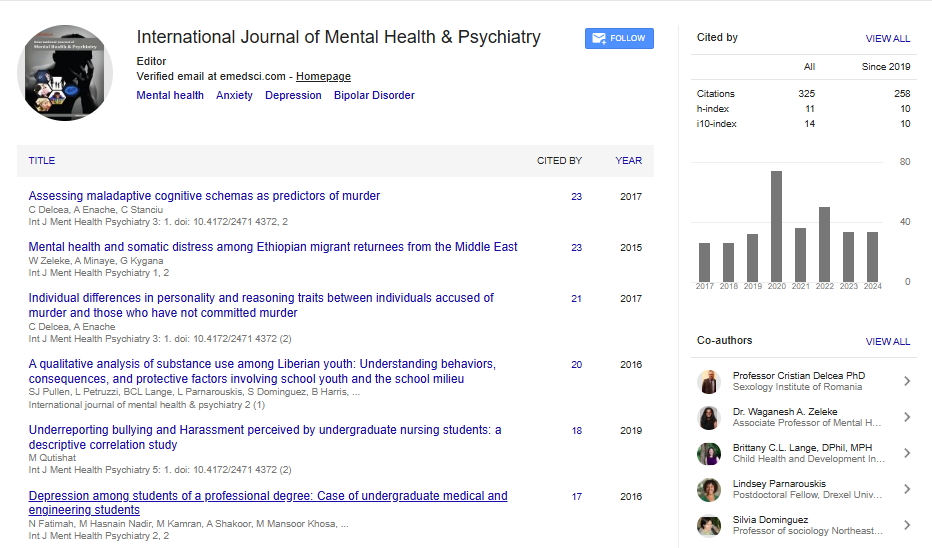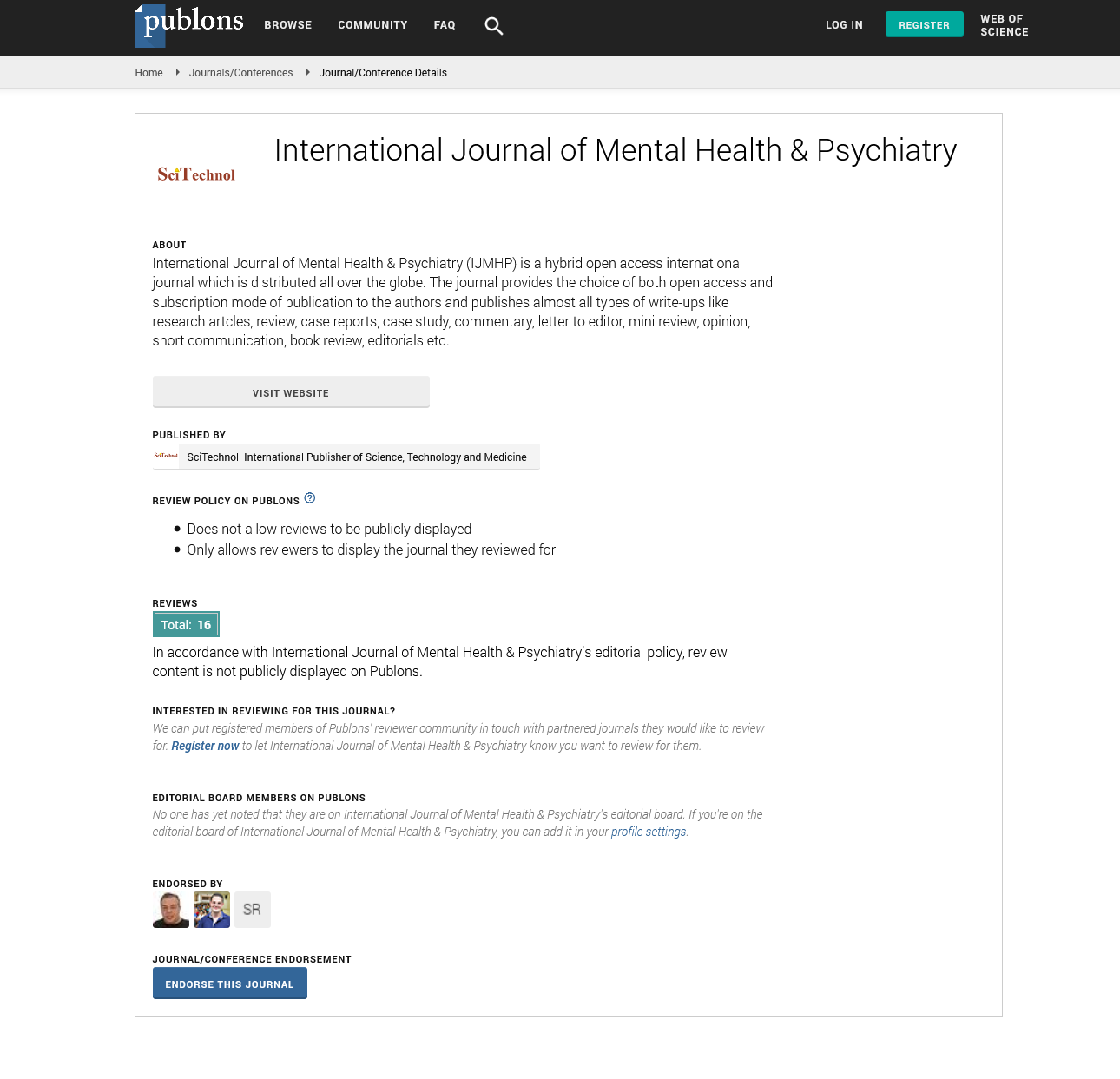Perspective, Int J Ment Health Psychiatry Vol: 10 Issue: 4
The Complexities of Hyperactivity Disorder in Modern Times
Laura Martinez*
1Department of Psychiatry, Harvard Medical School, Boston, USA
*Corresponding Author: Laura Martinez,
Department of Psychiatry, Harvard
Medical School, Boston, USA
E-mail: martinezl57@gmail.com
Received date: 26 November, 2024, Manuscript No. IJMHP-24-154315;
Editor assigned date: 28 November, 2024, PreQC No. IJMHP-24-154315 (PQ);
Reviewed date: 12 December, 2024, QC No. IJMHP-24-154315;
Revised date: 20 December, 2024, Manuscript No. IJMHP-24-154315 (R);
Published date: 27 December, 2024, DOI: 10.4172/2471-4372.1000275
Citation: Martinez L (2024) The Complexities of Hyperactivity Disorder in Modern Times. Int J Ment Health Psychiatry 10:4.
Description
Hyperactivity disorder, commonly referred to as Attention Deficit Hyperactivity Disorder (ADHD), is a neurodevelopmental condition that affects individuals across all age groups. Characterized by symptoms such as inattentiveness, impulsivity and excessive activity, this disorder often presents challenges in academic, professional and social settings. While ADHD is typically diagnosed during childhood, its effects often persist into adulthood, influencing various aspects of daily life. Hyperactivity disorder manifests through diverse symptoms, varying in intensity from person to person. Common indicators include difficulty focusing on tasks, frequent interruptions during conversations and an inability to remain still. Children with ADHD may exhibit disruptive behaviors in classroom settings, while adults might struggle with organizational skills or maintaining long-term commitments.
Diagnosis is a multi-step process involving clinical assessments, behavioral evaluations and sometimes psychological testing. Health professionals, including pediatricians, psychologists and psychiatrists, rely on standardized criteria outlined in the Diagnostic and Statistical Manual of Mental Disorders (DSM-5) to identify ADHD. Early and accurate diagnosis plays a precarious role in managing the disorder effectively. The exact causes of hyperactivity disorder remain unclear, but research suggests a combination of genetic, neurological and environmental factors. Family history significantly increases the likelihood of developing ADHD, as does exposure to prenatal risks such as maternal smoking, alcohol consumption, or stress during pregnancy. Neuroimaging studies reveal differences in brain structure and function in individuals with ADHD, particularly in areas related to impulse control and attention regulation.
Environmental influences, including early exposure to toxins like lead or childhood trauma, can also contribute to the disorder's development. It’s essential to understand that ADHD is not caused by poor parenting or a lack of discipline but is instead rooted in complex biological and environmental interactions. Management of hyperactivity disorder typically involves a combination of medication, behavioral therapy and lifestyle adjustments. Stimulant medications, such as methylphenidate and amphetamines, are commonly prescribed to enhance focus and reduce impulsive behavior. Non-stimulant options, like atomoxetine, may be recommended for those who experience adverse effects from stimulants or prefer alternative treatments.
Behavioral therapy plays an essential role in teaching coping mechanisms, improving communication skills and development selfdiscipline. Parents, educators and caregivers often benefit from training programs that equip them with strategies to support individuals with ADHD effectively. Lifestyle modifications, including regular physical activity, a structured routine and a balanced diet, can also significantly impact symptom management. Recent studies highlight the potential benefits of mindfulness practices and cognitive training in improving attention and emotional regulation.
Hyperactivity disorder often carries a stigma that can lead to misunderstandings and discrimination. Children with ADHD may be unfairly labeled as lazy or disruptive, while adults might face judgment in professional environments due to their perceived lack of productivity. Addressing these misconceptions through education and awareness campaigns is vital in creating an inclusive society. Advocacy groups and support networks provide essential resources for individuals and families affected by ADHD. These organizations offer counseling, workshops and community forums to share experiences and foster understanding. Public policies that promote early intervention and access to treatment are equally important in reducing the long-term impact of the disorder.
Advancements in neuroscience and behavioral research continue to shed light on hyperactivity disorder, flagging the mode for innovative therapies and interventions. Emerging technologies, such as digital health tools and personalized medicine, hold promise in tailoring treatments to individual needs. Additionally, greater integration of ADHD research into educational and workplace policies could lead to improved support systems for affected individuals. Hyperactivity disorder is a multifaceted condition that requires a complete approach to management. By development empathy, improving access to care promoting scientific research, society can better address the challenges associated with ADHD and unlock the potential of those who live with it.
 Spanish
Spanish  Chinese
Chinese  Russian
Russian  German
German  French
French  Japanese
Japanese  Portuguese
Portuguese  Hindi
Hindi 
